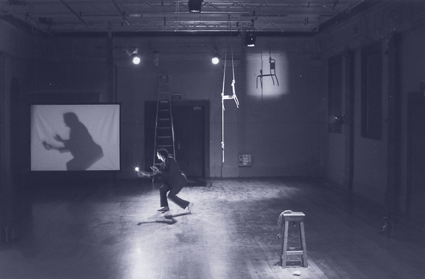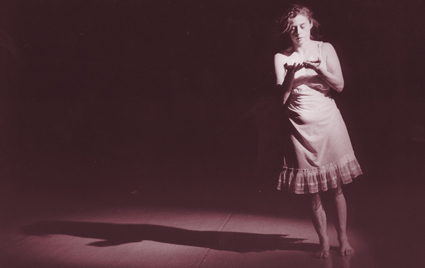Tests of the time
Zsuzsanna Soboslay, Mixed Metaphor Week Two

Christos Linou in Fiddle-de-die
photo Janet Williams
Christos Linou in Fiddle-de-die
1. Tolerance: Christos Linou, FIDDLE-DE-DIE/safety and uncertainty
He enters, descending a ladder, (literally) loses his marbles, walks backwards in, a towards that is also away, his shadow looming as he walks, enlarging, taking over. Later, he talks to it: a man in sheep’s mask, coercing his own shadow. Video shows legs running, stompings in corners of white floorless rooms. Voices invade, aspirations fail. This is a painfully fractured self who can barely tolerate himself, whose own ladder, his place of beginning, falls on top of him. Linou has devised a performance “dealing with drug addiction and AIDS”, the first of which is apparent, of the latter I’m not so sure.
At first, I am bothered by the angular restriction in Linou’s upper torso, though conjecture it may be appropriate to the portrayal. It is an empathetic piece on fractured self-obsession, that nonetheless might be trying of nerves, with its relentless calling, yelling and falling. I saw the piece only on video document (at the artist’s request after I had been called away), where the camera’s more intimate frame helpfully rendered both intimacy and distance.

Angela Pötsch, Temporal
photo Graham Farr
Angela Pötsch, Temporal
2. Tributes: Angie Potsch, Temporal
Reading Thomas Rimer’s account of working with Grotowski, about creating work from personal myths. Grotowski is punishing on Rimer when he keeps trying to be huge and meaningful, Rimer noting the way others slowly built long pieces from the smallest of honesties. Potsch’s piece seems to me to have such beginnings: glass, candlelight, the music of glass drawn round the perimeter of a water bowl. The body dancing here sometimes visible only as a fracture. Moving memory(ies). This is a piece which takes time with its qualities—simple elements built into a whole via an exquisite sense of rhythm. The only unfortunate segment is the “hair dance” (like the proverbial “hair acting”) where a private moment—perhaps of grief or loss—is veiled and kept introspected beneath all that lusciousness for too long.
3. Traces: Margaret Trail, Hi, it’s me
Hello, who’s speaking? the voice, vocaliser, or cyborg? Trail’s tripartite Hi it’s me progressively disappears the body, using strands of speech like rope, dissecting speaker from spoken and reknotting the weave. Part One is a jibbering of paranoid and more liberal selves, enacted as a dialogue between her real time, embodied voice (as Trail alternately sprawls, lounges and wriggles in a chair with an almost-endearing self-consciousness) and several taped versions. We next view her, “live with headphones”, seated at a mixing desk. She listens to her own recordings, wiggles her toes, occasionally calls out edits to a phantom producer, like Plato calling out for more light. The third part is a sound-and-light sequence in a darkened room: the edited tape and glimmers of colour like ribbons of remembered substance of the body(ies) which once spoke or telephoned. Are “bodies” ever more than this? I like this last piece, finding it very fine; the first two segments for me a little trying in real time.
4. Pellucid testings: Philipa Rothfield, Logic, with Elizabeth Keen and Jenny Dick
Philipa Rothfield’s Logic tests an intellectual proposition but does so in a way that engages the physical space. The body itself undergoes computations, negations, patternings; a parallel between a body thinking and a mind teasing out its own processes. The proposition of recited text and formulae projected on overheads, the body moving in a distinct yet parallel (con)sequence, sets the stage for the final “body solo” where the formulae, suggestions and patterns are allowed to follow their own logics, double, invert and redouble in a kind of gestural mathematics that is nourishing on many parallel planes and very finely honed. This is a thought-full and feeling-full piece with a gentle, sinewy strength that lingers long.
Logic makes no attempt to render the relationship of performing to seeing as a = b in a literal sense. The “equation”, if you like, is a matching of equal complexities, equal respect, between mind and body, audience and performers, maintaining their distinct qualities (speaker, writer, dancer, see-er). The performance, framed deliciously in a spare rectangular frame of light with projection screen behind, allows both space and fullness of response. Meaning comes through the way one takes a breath—before one equates an association.
These dancings are tests of the time, struggling with the threats of ideas, emotions and disappearances, questioning what is human, looking to what survives.
Mixed Metaphor Week Two, Dancehouse, North Carlton, July 2 – 5
RealTime issue #27 Oct-Nov 1998 pg. 4-5






